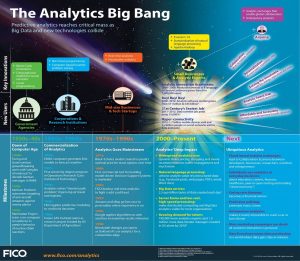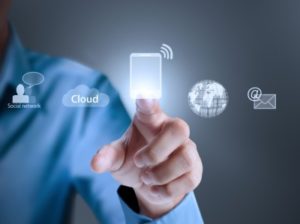Predictive Analytics – The New Magic 8 Ball
I remember when I was a kid and a popular toy that everyone loved to play around with was the Magic 8 Ball. You would ask it a multitude of yes or no questions to get its prediction for the future.
It is certain. Outlook Good. Don’t Count on It. Better Not Tell you Now. These were just a few of the answers from the “wise” ball with a floating icosahedron (20 faced) inside. I’m sure we have all had times in our life personally or professionally where we wish we had a “Magic 8 Ball” to guide us through life.
In a sense, we do have some tools out there that can help us forecast for the future which brings in the idea of Predictive Analytics. A tool that has actually been used for centuries without many of us knowing about it. In your everyday life, I’m sure you could find at least a few ways in which predictive analytics is used. From ads that come up to predict your future shopping habits to the increase or decrease of your credit score.
What is Predictive Analytics?
There are a few definitions out there but most define it as the following:
Predictive Analytics is the practice of extracting information from existing data sets in order to determine patterns and predict future outcomes and trends.
Predictive Analytics can not tell you what will definitively happen in the future but serve as a guide on the odds or risks of future events or occurrences. The accuracy and usability of the forecast is highly dependent about on the level of data and the quality of assumptions.
Often the unknown event of interest is in the future, but predictive analytics can be applied to any type of unknown whether it be in the past, present or future. For example, it can be used after a crime has been committed or after credit fraud has occurred. The core of predictive analytics relies on capturing data from past occurrences and using that data to predict the unknown outcome.
History of Predictive Analytics
Some will say that Predictive Analytics have been around since the 1940’s but others believe that it started back in 1689. A company you may have heard of, Lloyd’s of London, began the process which we know call underwriting. During this time period, shipping and trade was primarily conducted by traveling the seas.
Financial bankers would accept risk on a given sea voyage in exchange for a premium which was written on a Lloyd’s slip. Lloyd’s of London would obtain information regarding shipping news. This data would help forecast the risk of a particular sea voyage.
As I mentioned, others feel it started in the 1940’s when governments started using computational models. See the infographic below on the evolution of Predictive Analytics.

With the advent of AI, more data can be processed than ever before since it can operate without human intervention. The future of predictive analytics is endless. In fact, according to a report issued by Zion Market Research, the global market for Predictive Analytics is expected to reach approximately $10.95 billion by 2022. This is growing at a company annual growth rate of around 21 percent between 2016 and 2022.
How is Predictive Analytics Used Today?
There are many industries and professions that are currently using Predictive Analytics. Companies are trying to seek an edge in our very competitive market where they are fighting to survive and withstand long-standing problems.
Here are just a few of today’s Applications:
Automotive: Driver Assistance Technology where sensor data is analyzed to build assistance algorithms.
Aerospace: Using it to Improve aircraft up-time and reduce maintenance costs.
Child Care: Flagging high risk cases for potential child abuse.
Energy Production: Forecasting Electricity price and demand.
Financial sector: Credit risk models, identifying the most effective collection agencies, fraud protection, underwriting and project risk management are just a few of the uses.
Industrial Automation and Machinery: Predicting machine failures.
Law Enforcement: Crime Trend Data is used to define neighborhoods that may need additional protection at certain times of the year.
Marketing: Through data analysis marketers can predict customer buying habits, determine customer life cycles, and mitigate issues that could cause a loss of customer. By analyzing a customers’ spending, usage and other behavior this can lead to cross sales of additional products. Marketers are also using analytics to help identify the most effective combination of marketing tactics to target a given customer.
Medical: 93 percent of Healthcare Executives have stated that predictive analytics is important to their business’ future. A 2017 Society of Actuaries report discovered that over half of healthcare executives (57%) already using predictive analytics believe that the technology will help them to save 15 percent or more of their total budget over the next five years. It is currently being used to determine which patients are at risk of developing certain conditions like diabetes, asthma, heart disease and more.
Predictive Analytics and IT
IT Professionals around the world are constantly looking for tools to save them from a plethora of challenges. Outages, slow response time and network attacks are just a few of the problems impacting the IT world. Predictive Analytics can come in to help with some of these issues.
HPE’s InfoSight and Aruba’s NetInsight are solutions that are using predictive analytics. These tools can provide recommendations, real-time detection, accelerated troubleshooting and more for your network, servers and storage. Contact Zunesis for a demo on how these solutions work.
Will Predictive Analytics Continue to be used in the future? All Signs Point to Yes!
Strategic technology trends are defined as having potentially significant impact on organizations in the next three years. Here is a summary of a few trends according to Forbes; Gartner, Inc.; Computerworld; and other technology visionaries:
- Wearable Devices – Uses of wearable technology are influencing the fields of health and medicine, fitness, aging, education, gaming, and finance. Such devices include bracelets, smart watches, and Google glasses. Wearable technology markets are anticipated to exceed $6 billion by 2016.
- Cloud Computing – Gartner says cloud computing will become the bulk of new IT spend by 2016. Business drivers behind cloud initiatives include disaster recovery or backup, increased IT cost, new users or services, and increased IT complexity.
- Smart Machines – Smart machines include robots, self-driving cars, and other inventions that are able to make decisions and solve problems without human intervention. Forbes states that 60% of CEOs believe that smart machines are a “futurist fantasy” but will, nonetheless, have a meaningful impact on business.
- 3D Printing – 3D printing offers the ability to create solid physical models. The cost of 3D printing will decrease in the next three years, leading to rapid growth of the market for these machines. Industrial use will also continue its rapid expansion. Gartner highlights that expansion will be especially great in industrial, biomedical, and consumer applications, highlighting the extent to which this trend is real, proving that 3D printing is a viable and cost-effective way to reduce costs through improved designs, streamlined prototyping, and short-run manufacturing. Worldwide shipments of 3D printers are expected to double.
- New Wi-Fi Standards – Prepare for the next generation of Wi-Fi. First, the
 emergence of the next wave pf 802.11ac and the second development of the 802.11ax standard. Wi-Fi hotspots are expected to be faster and more reliable. Wi-Fi alliance predicts that products based on a draft of the standard will likely reach markets by early 2016.
emergence of the next wave pf 802.11ac and the second development of the 802.11ax standard. Wi-Fi hotspots are expected to be faster and more reliable. Wi-Fi alliance predicts that products based on a draft of the standard will likely reach markets by early 2016. - Mind-Reading Machines – IBM predicts that by 2016 consumers will be able to control electronics by using brain power only. People will not need passwords. By 2016, consumers will have access to gadgets that read their minds, allowing them to call friends and move computer cursors.
- Mobile Devices – Mobile device sales will continue to soar, and we will see less of the standard desktop computer. Worldwide mobile device shipments are expected to reach 2.6 billion units by 2016. Tablet PCs will be the fastest growing category with a 35% growth rate followed by smartphones at 18%.
- Big Data – Big data refers to the exponential growth and availability of data, both structured and unstructured. The vision is that organizations will be able to take data from any source, harness relevant data, and analyze it to reduce cost, reduce time, develop new products, and make smarter business decisions.
Only time will tell which of these will materialize as well as to what extent. However, one thing is certain: technology is getting faster, smarter, and more mobile by the minute. Interacting with technology any place and any time has become the norm, and this trend will continue to have a greater and greater impact on all types of organizations. Look up: George Jetson might be your next employee.

